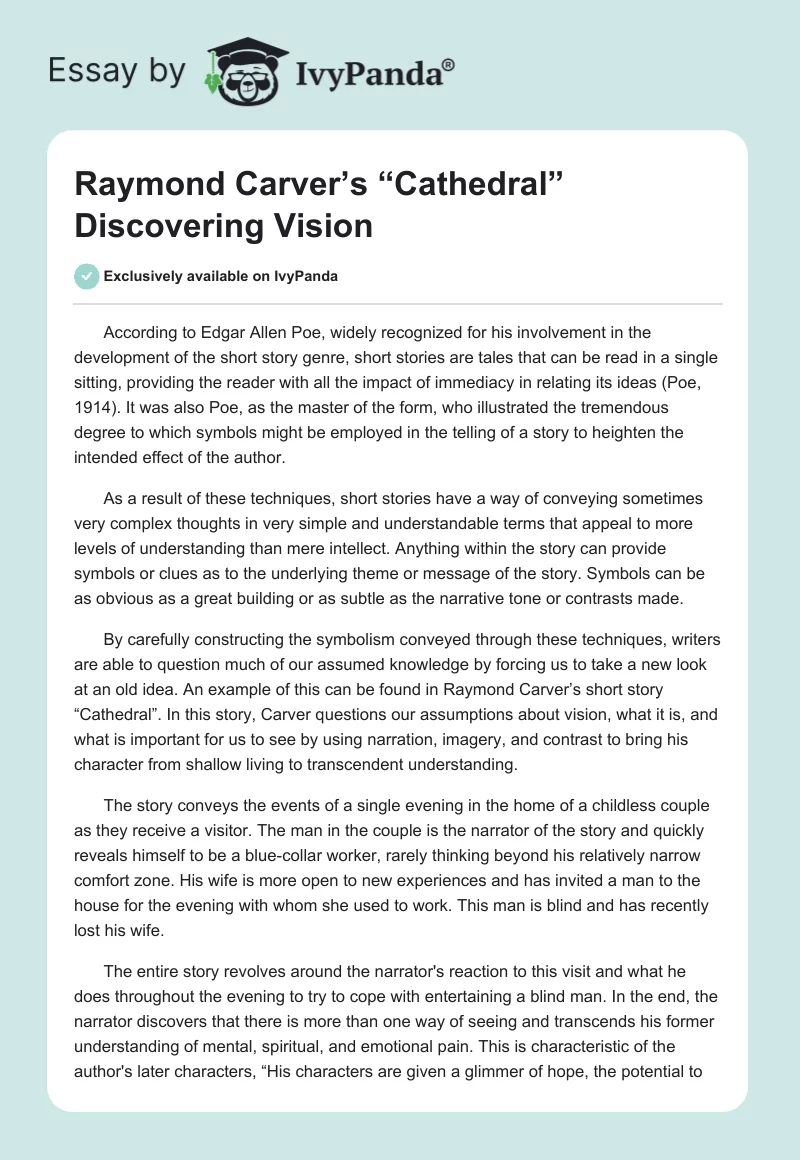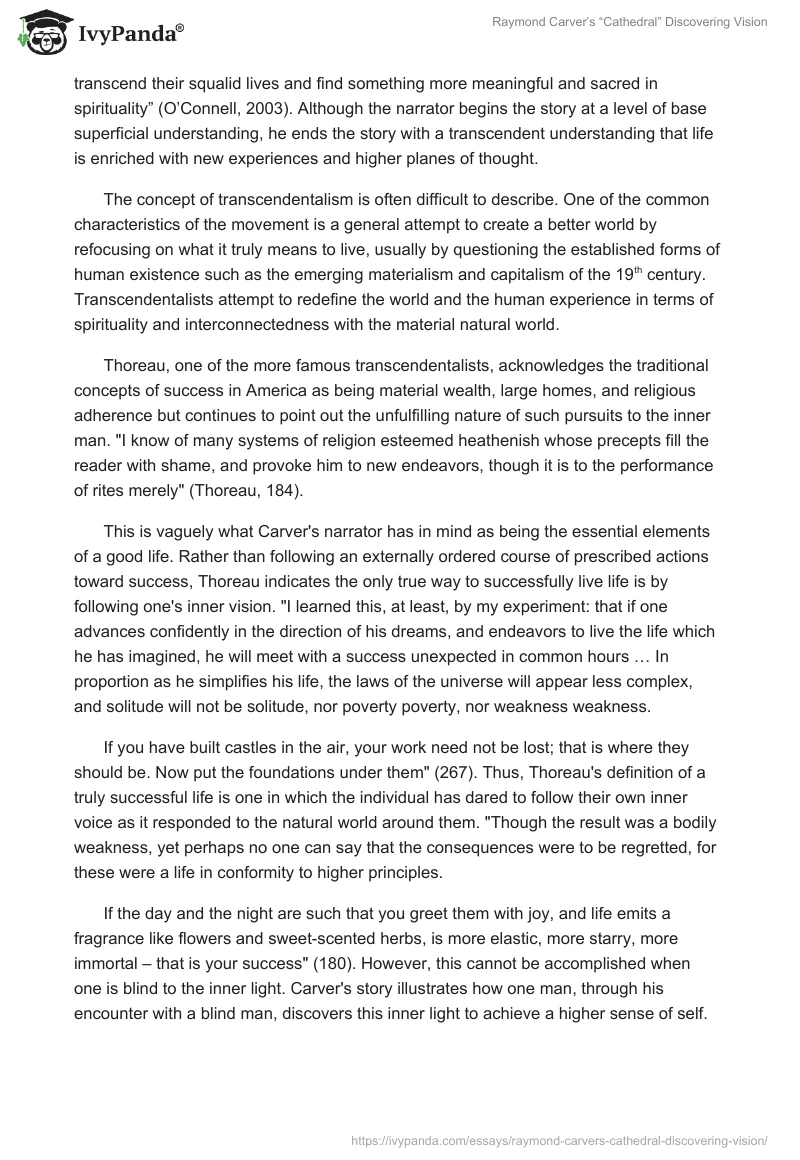According to Edgar Allen Poe, widely recognized for his involvement in the development of the short story genre, short stories are tales that can be read in a single sitting, providing the reader with all the impact of immediacy in relating its ideas (Poe, 1914). It was also Poe, as the master of the form, who illustrated the tremendous degree to which symbols might be employed in the telling of a story to heighten the intended effect of the author.
As a result of these techniques, short stories have a way of conveying sometimes very complex thoughts in very simple and understandable terms that appeal to more levels of understanding than mere intellect. Anything within the story can provide symbols or clues as to the underlying theme or message of the story. Symbols can be as obvious as a great building or as subtle as the narrative tone or contrasts made.
By carefully constructing the symbolism conveyed through these techniques, writers are able to question much of our assumed knowledge by forcing us to take a new look at an old idea. An example of this can be found in Raymond Carver’s short story “Cathedral”. In this story, Carver questions our assumptions about vision, what it is, and what is important for us to see by using narration, imagery, and contrast to bring his character from shallow living to transcendent understanding.
The story conveys the events of a single evening in the home of a childless couple as they receive a visitor. The man in the couple is the narrator of the story and quickly reveals himself to be a blue-collar worker, rarely thinking beyond his relatively narrow comfort zone. His wife is more open to new experiences and has invited a man to the house for the evening with whom she used to work. This man is blind and has recently lost his wife.
The entire story revolves around the narrator’s reaction to this visit and what he does throughout the evening to try to cope with entertaining a blind man. In the end, the narrator discovers that there is more than one way of seeing and transcends his former understanding of mental, spiritual, and emotional pain. This is characteristic of the author’s later characters, “His characters are given a glimmer of hope, the potential to transcend their squalid lives and find something more meaningful and sacred in spirituality” (O’Connell, 2003). Although the narrator begins the story at a level of base superficial understanding, he ends the story with a transcendent understanding that life is enriched with new experiences and higher planes of thought.
The concept of transcendentalism is often difficult to describe. One of the common characteristics of the movement is a general attempt to create a better world by refocusing on what it truly means to live, usually by questioning the established forms of human existence such as the emerging materialism and capitalism of the 19th century. Transcendentalists attempt to redefine the world and the human experience in terms of spirituality and interconnectedness with the material natural world.
Thoreau, one of the more famous transcendentalists, acknowledges the traditional concepts of success in America as being material wealth, large homes, and religious adherence but continues to point out the unfulfilling nature of such pursuits to the inner man. “I know of many systems of religion esteemed heathenish whose precepts fill the reader with shame, and provoke him to new endeavors, though it is to the performance of rites merely” (Thoreau, 184).
This is vaguely what Carver’s narrator has in mind as being the essential elements of a good life. Rather than following an externally ordered course of prescribed actions toward success, Thoreau indicates the only true way to successfully live life is by following one’s inner vision. “I learned this, at least, by my experiment: that if one advances confidently in the direction of his dreams, and endeavors to live the life which he has imagined, he will meet with a success unexpected in common hours … In proportion as he simplifies his life, the laws of the universe will appear less complex, and solitude will not be solitude, nor poverty poverty, nor weakness weakness.
If you have built castles in the air, your work need not be lost; that is where they should be. Now put the foundations under them” (267). Thus, Thoreau’s definition of a truly successful life is one in which the individual has dared to follow their own inner voice as it responded to the natural world around them. “Though the result was a bodily weakness, yet perhaps no one can say that the consequences were to be regretted, for these were a life in conformity to higher principles.
If the day and the night are such that you greet them with joy, and life emits a fragrance like flowers and sweet-scented herbs, is more elastic, more starry, more immortal – that is your success” (180). However, this cannot be accomplished when one is blind to the inner light. Carver’s story illustrates how one man, through his encounter with a blind man, discovers this inner light to achieve a higher sense of self.
From the beginning of Carver’s story, the narrator acknowledges his feelings of nervousness and uneasiness about having a blind man in his house which effectively reveals his own inner blindness. He says, “And his being blind bothered me. My idea of blindness came from the movies. In the movies, the blind moved slowly and never laughed. Sometimes they were led by seeing-eye dogs.”
In making this statement, the narrator is revealed to be a man blinded by ignorance because he can’t figure out an appropriate way of entertaining him. All he can think of is taking the blind man bowling, demonstrating a profound lack of imagination and ability to empathize. The narrator also makes a very false assumption that the man is black because his wife’s name had been Beulah. Throughout all of his considerations of the upcoming visit, the narrator’s thoughts are consistent in their lack of foundation and lack of reason.
He’s shocked that a blind man might choose to keep a full beard and cannot imagine what else to talk about that doesn’t center upon the visual. In the end, all he can think of to do is to turn on the television while he sits back and quietly studies the blind man. This introduction of him reveals the narrator’s internal blindness, unable to understand anything deeper than the surface and rendered mute by this obviousness.
Imagery provides the reader with a picture of what is going on in the story and, in this story, provides the first indication that the blind man is not as ‘blind’ as the narrator. The narrator tells us what his wife has told him about the blind man coming to visit, evoking a tender scene in which a very intimate and deeply moving connection was made between the wife and the blind man. “She told me he touched his fingers to every part of her face, her nose—even her neck! She never forgot it … In the poem, she recalled his fingers and the way they had moved around over her face. In the poem, she talked about what she had felt at the time, about what went through her mind when the blind man touched her nose and lips.”
As he tries to decide what to talk about with the blind man, the narrator cannot seem to get away from the visual, wanting to suggest which side of the train to sit on for the best view of the Hudson. Finally, though, it is imagery that marks the difference between the two men as one thinks only in terms of pictures and the other, upon reflection, must admit that he really has no idea of what is meant by the word ‘cathedral’. Although the mentally blind narrator is perfectly capable of physically seeing what the cathedral looks like, he is not able to describe it in any means other than the simple visual ideas of height and space.
The symbol of the cathedral reveals the author’s intentions to introduce more transcendent ideas which the blind man is capable of discovering a way to communicate with an inarticulate individual and provide a bridge for this same individual to transcend the distance between them.
The blind man manages to do this by discovering a way that the narrator might ‘show’ him what a cathedral might look like and then instructing the narrator regarding another means of ‘seeing.’ Later in the story, there is a profound image of the blind man placing his hand over the top of the narrator’s hand as the narrator draws his picture of a cathedral on the side of a shopping bag. This image is very like the image of a parent guiding the hand of a child and reinforces the idea that the physically blind man is guiding the sight of the spiritually blind man.
It is through the contrast between the sighted and unsighted men that the author manages to bring out questions regarding our understanding of the concept of vision and where we place our importance. This begins to emerge as the blind man is described in contrast to the narrator’s previous speculations. The blind man “wore brown slacks, brown shoes, a light-brown shirt, a tie, a sports coat. Spiffy. He also had this full beard.
But he didn’t use a cane and he didn’t wear dark glasses. I’d always thought dark glasses were a must for the blind.” While the narrator is obviously not that interested in learning about things, the blind man is open to new experiences and new ideas. This is evident not only in the many professions he talks about having engaged in but also as he casually tries marijuana for the first time and the way he demonstrates his interest in learning more about cathedrals simply because the opportunity presented itself.
In encouraging the narrator to draw a cathedral together as a means of ‘showing’ the blind man what a cathedral is, the blind man manages to open the narrator’s eyes, and the reader’s as well, to the various ways in which the world might be seen differently. “My eyes were still closed. I was at my house. I knew that. But I didn’t feel like I was inside anything. ‘It’s really something,’ I said.” Through his participation in the evening, the narrator has had a transcendent experience that profoundly affects the way he understands his world. He has discovered that the eyes are not the only techniques through which an individual might see or understand the world and begins to discover what some of these other sensory inputs might have to contribute.
Through imagery, narration, and contrast, Raymond Carver manages to demonstrate how many people are blinded by their fixation on a single sense or a single, ill-informed idea. In presenting the blind man as a normal human being capable of thought and adventure, Carver contrasts this far-seeing man with the sighted blindness of the narrator and suggests that blindness is often a matter of choice.
Only by trying something new, attempting to ‘see’ things from another’s perspective, and leaving oneself open to the possibilities of new experiences can growth and true sight be obtained. Thus, through the story, Carver illustrates how the blind might actually lead the blind to a more positive conclusion.
Works Cited
Carver, Raymond. “Cathedral.” Name of book. Place of publication: publisher’s name, date of publication: page numbers where story is found.
O’Connell, Evan. “Raymond Carver.” Mercer Street. (2003). Web.
Poe, Edgar Allen. “The Philosophy of Composition.” (1914). Bob’s Byway. (2008). Web.
Thoreau, Henry David. Walden. New York: Barnes and Noble Books, 1993.


